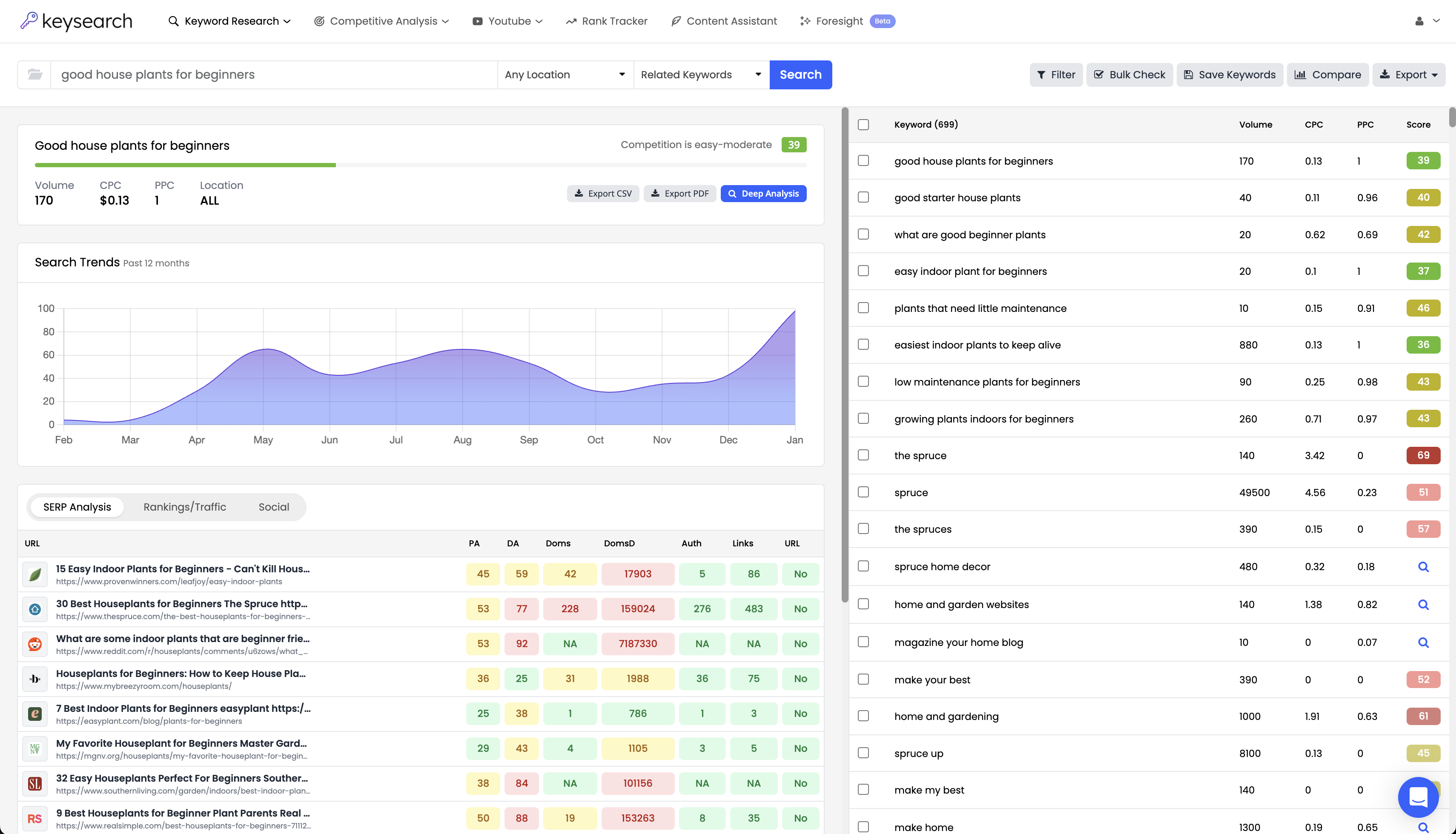So you’ve done all the hard work of conducting keyword research, building high-quality content, and perhaps even working on off-page SEO, sending links to the target URL.
You wait a few weeks, maybe even a few months…but you’re not seeing any traction in the SERPs. What gives? You followed our keyword research checklist to perfection and yet you’ve seen no progress.
While it could be that you’re targeting too difficult of keywords relative to your site’s authority, there’s also a good chance you’re stuffing keywords. That’s why we want to walk you through how to check keyword density in SEO to help you optimize your content accordingly.
The optimal KW density is between 2-8%, but we suggest being even more narrow in your targeting and aiming for 4-6%. Learn how to calculate keyword density manually below, or better yet, save yourself the time and stress by using our keyword density checker.
This tool allows you to input a URL and automatically gauge the density of your target keywords so you can adjust accordingly. When paired with our other free SEO tools, mapping out and executing an effective SEO strategy couldn’t be easier!
Overview of Keyword Density
First, what is keyword density? This refers to the percentage of times a keyword or key phrase appears in a piece of content relative to the total word count. It’s a metric search engines use to understand your content’s relevance to specific search queries. Put in more simple terms, it assesses how many times you use a keyword on a page.
So, how is keyword density calculated? The formula is simple and straightforward:
(Number of times the keyword appears / Total word count) x 100 = KW density.
For example, if your article is 1,000 words long and your target keyword appears 10 times, your keyword density would be 1%. We’ll talk about whether or not this is an optimal density in a moment. Let’s look at the importance of knowing how to check keyword density first.
Why KW Density Matters
In the past, SEOs would simply stuff their target keyword as much as possible into the text on a webpage, no matter how unnatural it looked to the human eye. It worked to boost rankings – whether it actually converted or not is a conversation for another day.
However, the Wild, Wild West of SEO is well behind us. Far too many algorithm updates have been released for keyword stuffing to be effective in this day and age. Here’s why you need to be more meticulous in your keyword structuring:
- Search Engine Rankings: Search engines like Google use keyword density as a factor in their ranking algorithms. While Google has denied this sentiment in the past, we know it to be a fact now after the recent API leaks. While it’s just one of many factors, having the right keyword density can improve your chances of ranking higher in search results.
- Content Relevance: Proper keyword density keeps your content relevant to the topic at hand. Again, this helps search engines match your content with user searches, thereby boosting visibility.
- Avoiding Keyword Stuffing: Overusing keywords can lead to penalties from search engines, ultimately doing more harm than good. We’ll help you avoid this with tips on how to calculate keyword density below.
Today, achieving the right keyword density is about striking a balance. Too few keywords can make your content irrelevant to search queries, while too many can lead to keyword stuffing.
So, where’s the sweet spot – what’s the optimal keyword density?
What is the Optimal Keyword Density?
Just as with questions like what is a good keyword difficulty score, there’s no one-size-fits-all answer as far as your ideal KW density goes. There are simply best practices, and it’s up to you to figure out where you fall on the density scale.
That being said, the general consensus is that a range between 1% and 2% offers a good balance of sending proper ranking signals without looking spammy in the eyes of algorithms. This means that for a 1,000-word article, your target keyword should appear about 10 to 20 times.
However, we like to be a bit more modest in our keyword targeting efforts, aiming for a KW density between 0.5% to 1% max. For the same 1,000-word article we’ll only use our target keyword 4-6 times. For a 2,000-word article, we’ll aim for 7-10 uses.
As far as secondary/long-tail keywords go, we like to be even more conservative and shoot for a KW density between 0.25 to 0.5%. So – for a 1,000-word article, we’re using secondary keywords 2-3 times.
But remember that as with most things in SEO, there are far too many moving pieces to give a black-and-white answer. There is so much nuance at play, including:
- Content Type: A product or category page might have a higher keyword density compared to a blog post, as product pages need to emphasize specific terms related to the product.
- Keyword Competitiveness: Highly competitive keywords might benefit from a slightly higher density within the optimal range to compete effectively. However, you still need to balance density with providing value to readers.
- Article Length: For longer articles, maintaining a consistent keyword density becomes easier. You can naturally incorporate keywords throughout the text without overstuffing. For shorter articles, focus on placing keywords strategically in key areas like the title, headings, and introductory paragraphs.
We’ll share more tips on actually structuring your content accordingly, but for now, let’s get into how to calculate keyword density below using two different methods.
How to Check Keyword Density in SEO
We touched on this earlier, but you don’t need to stress about how to check keyword density in SEO. It couldn’t be any easier thanks to our tool here at Keysearch. We’ll show you how it works along with some advice on manually calculating KW density.
Use Our Keyword Density Checker Tool Free
As we discuss in our guide on how to automate keyword research, time is money. Our SEO toolkit seeks to help you earn higher rankings with less work and time – thereby boosting your ROI. In just a click you’re able to effortlessly assess keyword density.
The keyword density checker we’ve created is unlike any other available. Simply input your URL and the tool will analyze the content length relative to your keyword frequency. You’ll be met with suggestions to optimize the content if necessary – not just for the primary keyword, but for secondary keywords as well.
The best part? This is just one of the 12+ tools you’ll have in your arsenal when you sign up for a Keysearch account. Our suite truly contains everything you need to map out and execute a successful SEO strategy at the most affordable price possible. In fact, many of our tools are entirely free until you start to scale up and need more capabilities.
From our niche finder that helps you set out on the right foot to our top keywords list that uncovers the best opportunities, here are some of our most popular solutions alongside our keyword density tool:
- Keyword clustering tool
- Keyword difficulty checker
- LSI keyword generator
- Long tail keyword generator
- Amazon keyword tool
- eBay keyword tool
- Etsy keyword tool
- Pinterest keyword tool
- YouTube keyword tool
So, see for yourself how simple checking keyword density can be with our intuitive tool at Keysearch today. After comparing it to the manual method below, you’ll see why it’s the #1 choice!
Manually Calculate Keyword Density
While automated tools are highly efficient, understanding how to calculate keyword density manually can give you deeper insights into your content optimization process. Here’s how you can do it:
- Identify Your Keywords: Both primary and secondary keywords you want to target.
- Count Total Words: This can be done using a word processor’s word count feature like Google Docs.
- Count Keyword Occurrences: Use the control + find feature to see how many times each keyword appears in your content. Ensure you include variations (like singular vs plural).
- Calculate Density: Use the following formula to calculate keyword density: (Number of times the keyword appears / Total word count) x 100 = KW density.
- Analyze Results: Compare your findings to the optimal range we mentioned earlier. If it’s above 2%, you’re definitely going to want to trim some fat from the content.
Now What?
Maybe you’ve discovered your keyword density is dialed into the perfect range – great! You can continue the process for each page you want to analyze. But what if you find that you’re overstuffing keywords? Here are some tips to optimize your content.
Understanding the Most Important Places to Put Keywords
You’ll need to reduce keyword frequency if your density is above the recommended range, but where should you delete keywords from in the content to avoid detracting from your efforts?
There are a few places where keywords have the most pull, and these should be left untouched. Some places to prioritize keyword placement include:
- Headings and Subheadings: Use keywords in your H1, at least 1-2 H2s, and other H3s if necessary to signal the structure and main topics of your content to search engines.
- Introduction and Conclusion: The earlier on you get your keyword in the introduction, the better. Similarly, try to get the keyword in the outro as well to tie the entire piece together.
- Body Content: Naturally weave keywords throughout your body content, spacing them out well. For example, if you’re using a keyword 4 times in your article body you wouldn’t want 3 of those uses in the same paragraph.
While this doesn’t have anything to do with keyword density, you also need to ensure keywords are placed in title tags, meta descriptions, URL slugs, and image alt text.
Filling in the Gaps With Long Tail and LSI Keywords
Instead of removing keywords altogether, consider replacing them with long tail keywords or LSI keywords. These will help you branch out and rank for less competitive terms that drive additional authority and relevancy to your web page.
Long tail keywords are more specific phrases that users search for. They often have lower competition and can attract more targeted traffic.
On the other hand, LSI keywords are related terms that help search engines understand the context of your content. They enrich your article and prevent keyword stuffing.
We have tools here at Keysearch specifically for uncovering these opportunities, helping you cover all your keyword bases to create the best possible content.
Always Create Content for People First, Bots Second
At the end of the day, understanding keyword density is as simple as remembering that content should be created to satisfy user intent and create value – attempting to persuade bots of your content’s relevance is a secondary priority.
Write in a natural, engaging tone that appeals to your audience. Content should be easy to read and informative. Focus on solving problems and providing actionable insights.
If you can fit keywords in naturally, great! If not, don’t sweat it. As long as you place them in the important places we mentioned above and create a quality resource, you can get away with a lower KW density.
Learn more about how to do Etsy keyword research, how to do Pinterest keyword research, how to do keyword research for YouTube, or what to do after keyword research in our blog if you’re interested. Otherwise, it’s time we wrapped up our guide on how to check keyword density below.
Final Thoughts on How to Calculate Keyword Density
There you have it, everything you need to know about how to calculate keyword density. This is an important aspect of content creation as there’s a fine line between sending ranking/relevancy signals and coming off as spammy in the eyes of search engines.
It can be the difference between page-one rankings and your content never making it out of the depths of the SERPs. So, take what you’ve learned in this guide to checking keyword density and put it to the test, starting with Keysearch’s keyword density tool today.
Want to see how it stacks up to the competition? Compare our tool to others below:
Or, better yet, get started for free today and discover firsthand why Keysearch is trusted by 10,000+ small bloggers and massive businesses alike. Streamline your keyword research and content creation efforts with our toolkit!
- How to Do Keyword Research for Free: Best Free Keyword Research Tools in 2024 - December 13, 2024
- Benefits of Keyword Clustering: Why is it Important to Group Relevant Keywords Together? - December 13, 2024
- What is Keyword Density in SEO and Its Importance - December 13, 2024







